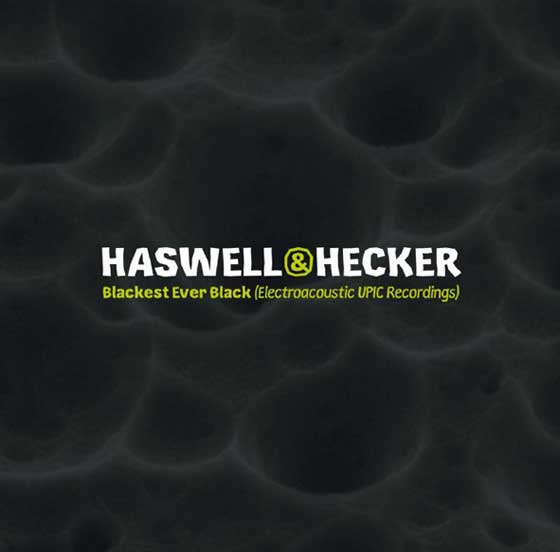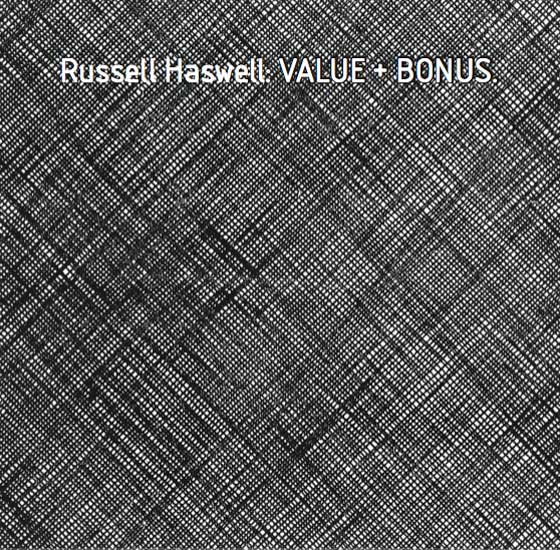|
|
| No!se Kaspars Groševs, Artist Haswell & Hecker – Blackest Ever Black (Warner Classics, 2007) Russel Haswell – Value+Bonus (No Fun Productions, 2010) | |
 Haswell & Hecker. Blackest Ever Black. CD | |
| Haswell & Hecker – Blackest Ever Black (Electroacoustic UPIC Recordings) (Warner Classics, 2007) Two of today’s most conspicuous noise makers – Russell Haswell and Florian Hecker – have created quite a substantial and even relatively academic work, which a lot of listeners could no doubt find rather frightening or even excruciating listening material. Still, it all started a little more than fifty years ago with a very noble desire to give people without a musical education the possibility of creating musical works intuitively. The idea of converting graphic drawings into music came to electronic music trailblazer Iannis Xenakis at the beginning of the 1950s, but it really only came to fruition 25 years later in collaboration with scientists at the CEMAMu [Centre d’ Etudes de Mathematique et Automatique Musicales] in Paris. The UPIC [Unite Polyagogique Informatique du CEMAMu] computerized system allows one to “draw” the musical work’s structure on an interactive plane – the vertical axis defines the sound pitch, and the horizontal – the length. The composer’s view was that the drawing done by hand unites mental calculation and natural accidents. Although it was meant to be a widely available tool which would allow anyone to create music, UPIC didn’t start mass production, and even Xenakis himself has used it very rarely. For example, the 1978 Mycènes Alpha musical work contains the composer’s drawings which remind us of sinewy, organic forms. Haswell and Hecker decided to bring new life to the UPIC and to use it in the creation of new work. Being in residence at CCMIX (Xenakis Music Composing Centre), the artists had the opportunity to experiment with a variety of visual materials – abstract drawings, art reproductions, pornography, horror scenes etc., to get as many different results as possible. The work that can be heard in this recording, which in terms of its academic spirit is split into four parts, has been assembled from the materials gained during residence. These, in ever varying combinations, also get used when the two perform together, each of these performances being numbered. The artists usually request concert organizers to provide the most powerful lighting effects possible. We were able to observe this in Riga as well – during the UPIC Diffusion Session #17, the audience was swallowed up by thick swirls of smoke, coloured lasers, a stunning stroboscope and, of course, the UPIC sound micro-particles attacking from all directions. The concert venue became like a hot sauna, which was difficult to enter, but once you did, the heat enveloped you and recharged you. This recording, despite its rather formal and even a little hackneyed challenge – the use of shocking images in the creation of the work, is an achievement worthy of note among the artists’ creative works, which are largely known for their seemingly uncontrolled computer-generated noise improvisations. Blackest Ever Black has been masterfully put together from the most diverse UPIC computer electronic sounds – penetratingly buzzing, jerky and clamorous, humming and flowing, at times becoming even eerily melodic. However, in the recording there is not a trace of any self-indulgence with the new toy or a merely mechanical transformation of images into a flow of noise. This work has been created by two living breathing people, who have been able to arrange and assemble the entire electronic signal mass into an opus more than 70 minutes long, without being afraid of either grating oversaturation or moments of silence – which can be startling to the listener. The cleanness of the harsh unnatural sounds and even its paradoxical clarity sets this recording apart from the majority of current noise music recordings and places it in the last decade’s list of the most interesting musical events. Videos from the UPIC “diffusion sessions” can be found on the artist’s blog at haswellhecker.blogspot.com. The recording can be purchased at boomkat.com and elsewhere. | |
 Russel Haswell. Value+Bonus. CD | |
| Russell Haswell – Value+Bonus (No Fun Productions, 2010) Besides their successful joint work, both artists are also very active individually, both in music as well as in visual art, releasing recordings, organizing and taking part in exhibitions, performing in concerts, etc. Hecker has recently gained a certain amount of attention at sound art exhibitions, as has the album Acid in the Style of David Tudor released last year, the title alluding to both rave music as well as to the legendary avant-garde musician and pianist David Tudor, who also participated in the first performance John Cage’s famous work 4’33”, and the improbable combination of both. In contrast to the sterility of Hecker’s mathematical noise (which is not pleasant to the ear), Haswell’s solo recordings, in the main, sound the complete opposite – brutal, dirty and uncontrollable. In his best known albums of the Live Salvage series, the already chaotic nature of the music is muddied even further by the use of live concert recordings, in which one can hear both people talking, as well as the inter¬action of the sound with the acoustics of various spaces. Haswell’s latest achievement offers a new perspective on his creative work and extreme noise music as such. Test compositions form the introduction to the first disc, during which the listener’s sound system is checked in a slightly absurd way – is the right and left channel working, can very low bass frequencies and high-pitched noises be heard. This is followed by a warning that the “artist and the recording company wish to warn the listeners that extended listening to this recording loudly could damage your audio system and ears. Please don’t turn the sound up to the maximum.” And then nO!se begins. At the start, there is a demonstration of the synthesized basic noises, the names revealing all the practical details – the origin of the noise as well as the capacity of the microphone used. Similarly, in the next, the eighth composition in order, we hear a sinus sound wave, which gradually gets turned up louder and louder until it transforms into a piercing whooshing. It seems that the first 8 pieces are a kind of mental and practical preparation for what’s coming – brutal, ear-damaging noise improvisations, which were recorded ‘live’, without any editing afterwards. On the album cover, Haswell honestly reveals all the means used, similarly to the way that the composition titles tell us about their character and origin. In the next compositions a number of noise improvisations are played, mostly reminding us of noise music “classics”. However, in individual pieces Haswell’s interest in pop music and dance music deconstruction is revealed, for example, Acid nO!se begins with a typical 80s rave bass line sequence, which soon grows into a bubbling storm of noise, whereas in Coventry a deep techno rhythm loop gets distorted until it is unrecognizable. The first disc concludes with a concert recording characteristic of Haswell, where after an intensive performance one can hear people’s conversations, comparing what they’ve heard with a multiplied guitar sound of Jimmy Hendrix. The album’s second disc (Bonus) is introduced by the monotone synthetic screeching of seagulls and a waves crashing, followed by an hour of uncut radio FM, MW, LW and SW wave scanning, unhurriedly searching for interesting chat and music fragments, which are familiar to everyone. A suitable finish for a recording made with unshakable composure, which at times is both unbearably suffocating, as well as cleverly conceptual. The recording can be purchased from www.nofunproductions.com. /Translator into English: Uldis Brūns/ | |
| go back | |







